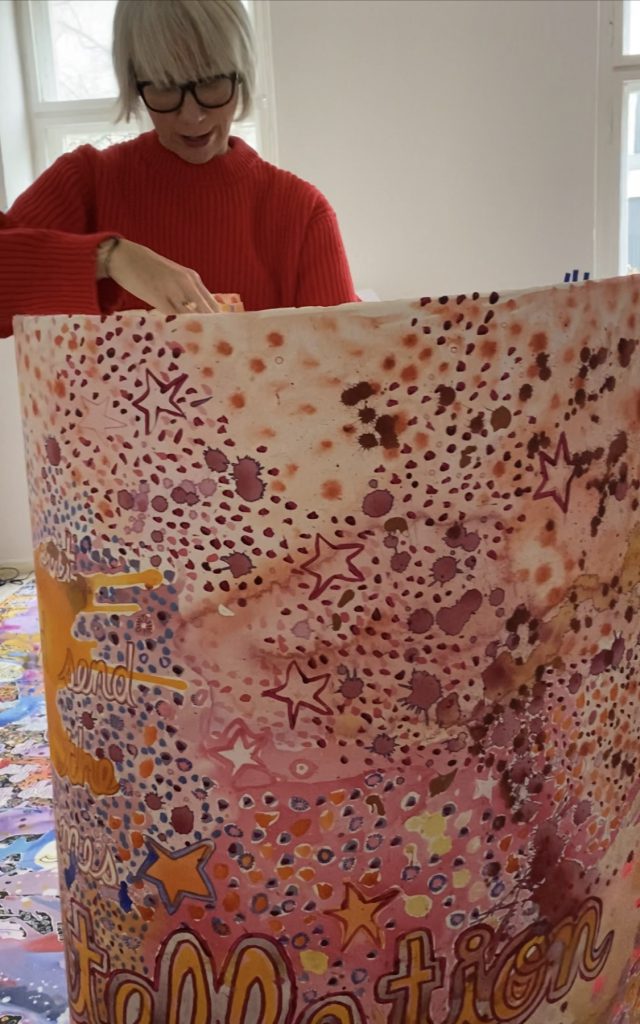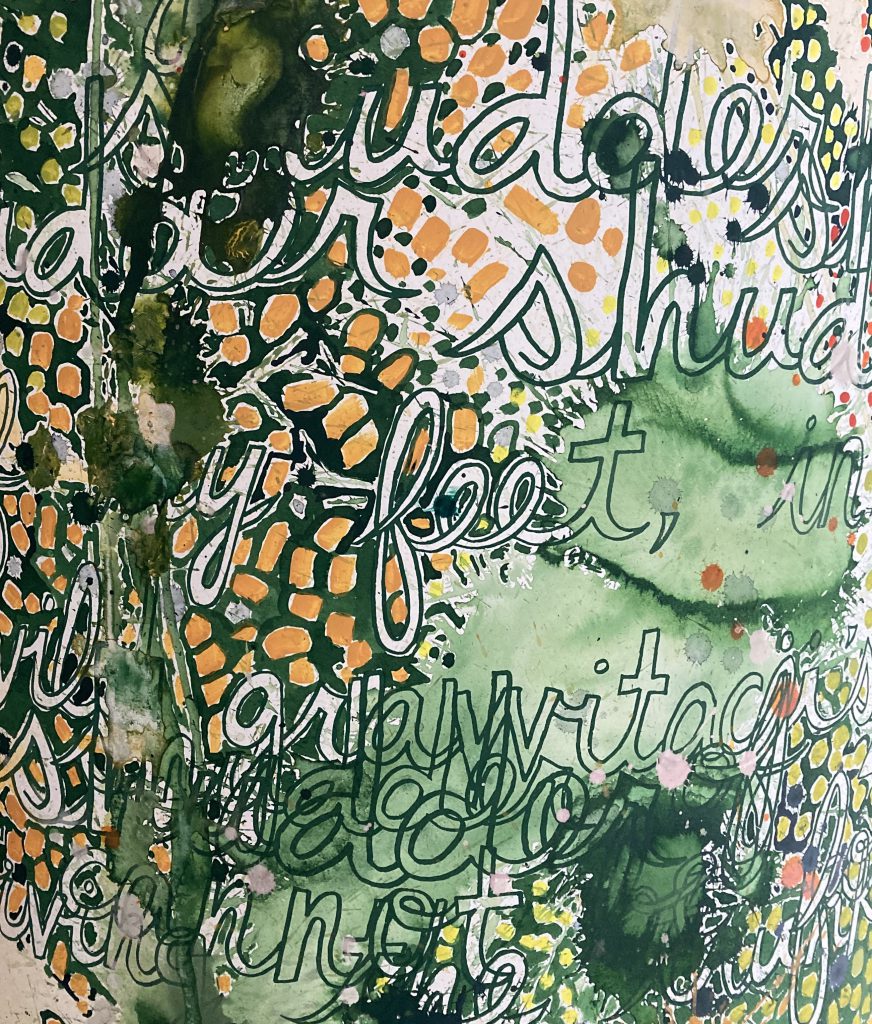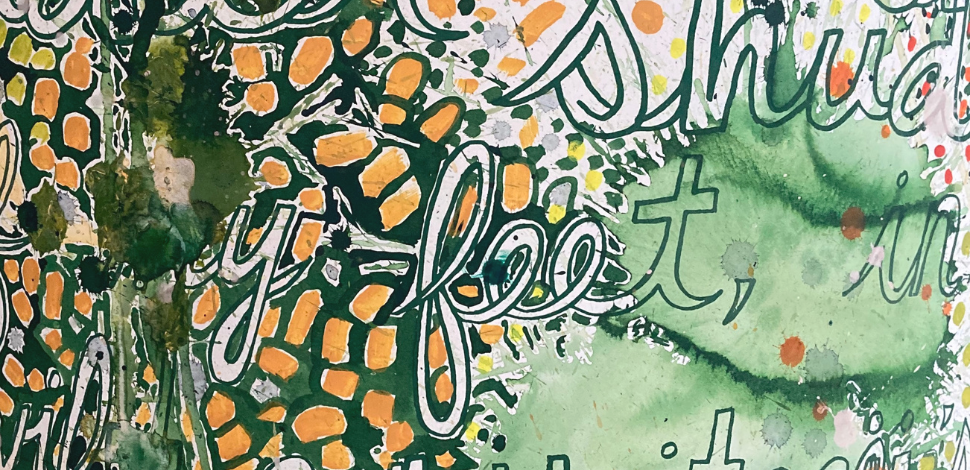Galerie calier I gebauer Berlin and Hahnemühle are pleased to announce Everything Belongs to the Cosmos, Alexandra Grant’s first solo exhibition at the Berlin gallery on Hahnemühle paper. The large-scale installation will comprise six paintings, creating a chapel space – literally a cosmos – of mixed media works, each 3.9 metres high and at least 3 metres wide. The works in various painting and printing techniques on The Collection Watercolour Paper are the largest works Alexandra Grant has ever created.

A chapel space for poetic and visual art
Everything Belongs to the Cosmos is an installation of painted works by Los Angeles and Berlin-based painter Alexandra Grant based on texts by Polish poets and writers Anna Adamowicz, Krystyna Dąbrowska, Julia Fiedorczuk, Bianka Rolando, Olga Tokarczuk, and Urszula Zajączkowska. Begun in 2021, the work is designed to create a chapel for reflection and space for hope, following in the rich tradition of contemplative chapel spaces created by artists as diverse as Henri Matisse, Mark Rothko, Ilise Greenstein and Theaster Gates. The six participating poets were chosen and commissioned in 2021 and early 2022 with the assistance of Marcin Orliński and the contributed work was translated from Polish into English by Antonia Lloyd-Jones.
The curiosity that drives Grant’s career is in literary texts and making them visual. Since 2014, her work has revolved around Sophocles’ myth of Antigone, interpreting her utterance “I was born to love not to hate.” She has painted Antigone’s voice with drawn lines (to represent the rule of law) and bright pours of paint (which capture the chaos of life). In Neunte Universum (Ninth Universe), 2020, painted and exhibited in Berlin in 2021 at carlier | gebauer gallery, her Antigone series expanded to include the universe itself. This painting was technically and culturally a springboard for Everything Belongs to the Cosmos.
The Polish poets and writers featured in Grant’s painted Cosmos span generations and levels of recognition, with Tokarczuk the winner of the 2019 Nobel Prize in Literature and are meant to highlight the current writing scene in Poland as each interprets an aspect of the cosmos. Taking each writer’s text as a cue, Grant created one large-scale painting based on each text in English, each on paper and at a scale of 3.9 meters tall and 3 meters wide or larger, the largest works she has ever created. The installation of the six paintings is meant to create a chapel space – and quite literally a cosmos – for and of women’s voices.
Translating words into the visible and visual
Engaging the community of Polish poets and writers during the pandemic, the Ukraine war and refugee crisis, as well as the changing political circumstances for women in Poland has allowed for cross-cultural exchange and opens a conversation around the purpose of and hope that writing, art-making, reflection and community can bring. By commissioning the poets and writers and having their work translated to English by Antonia Lloyd-Jones, Grant’s aim is “to further translate their words into the visible and visual.”
The title of the exhibition captures both a sense of wonder and a surrender to reality and circumstances, which allows for a transcendence of material conditions. Everything Belongs to the Cosmos is a safe haven: a place for reflection and hope, both part of and apart from the chaos of the world.
Grant’s interest in Polish literature began over 20 years ago, when she first read Wislawa Szymborska’s work and embarked on representing the poem “Possibilities” as a drawing without paper, made out of wire, in 2001. These sculptures and works stemming from them are now the subject of a solo show at the Adam Mickiewicz Museum of Literature in Warsaw, Poland, Alexandra Grant. Word. Image. Space, a survey of her work that presents a long-term interest in Polish literature and experimental writing, focusing on works inspired by Szymborska and Michael Joyce.
A public conversation led by Lloyd Jones and Marcin Orliński, featuring Adamowicz, Dąbrowska, Fiedorczuk, Rolando, and Zajączkowska, will take place on Saturday, 23 November 2024, at 4 pm.

The exhibition is open from 23 November 2024 to 11 January 2025 at Galerie carlier | gebauer, Berlin. Tuesday to Saturday 11 am – 6 pm.
Markgrafenstraße 67, 10969 Berlin
A bilingual catalog of Everything Belongs to the Cosmos will be released in January 2025. The book will include an essay by Marcin Orliński, as well as the texts by the six Polish poets and writers.
About the artist
Alexandra Grant lives and works between Los Angeles and Berlin. She has exhibited at international institutions such as the Orange County Museum of Art, Costa Mesa, CA (2023); Los Angeles County Museum of Art (LACMA), Los Angeles, CA (2016); 20th Bienal de Arte Paiz, Guatemala City, Guatemala (2016); The Broad Museum at Michigan State University, East Lansing, MI (2014); The Contemporary Museum, Baltimore, MD (2007); and the Museum of Contemporary Art (MOCA), Los Angeles, CA (2007). Her work has been written about in the Los Angeles Times, White Hot Magazine, Frieze, Art in America, and Artforum amongst others. Awards include the COLA Individual Artist Fellowship and The Pollock-Krasner Foundation Grant. Her works are included in museum collections such as the Los Angeles County Museum of Art; Museum of Contemporary Art, Los Angeles, CA; the Orange County Museum of Art, Costa Mesa, CA; and the Blanton Museum of Art, Austin, TX.
About the paper
The Collection – Watercolour 300 & 640 gsm – 100 % cotton rag – mould-made – surface sized – available cold pressed, rough and hot pressed
Hahnemühle The Collection Watercolour 300 and 640 set new standards for high-quality watercolour papers. A carefully chosen variety of cotton offers extremely strong fibres and incomparable purity – also suitable for Mixed Media. The selection of the best raw materials and exclusively natural filler materials gives the Watercolour 300 and Watercolour 640 papers their unparalleled quality.
The prized cotton papers, Watercolour 300 and 640, are characterised by a very durable paper surface that is well suited for demanding watercolour techniques. The fibres do not lift, rub off or loosen, even when applying multiple layers of colour, or when using masking fluids and tapes. This paper lets you use the most beautiful colours and create remarkable wet-on-wet paintings.
Hahnemühle The Collection Watercolour 300 and 640 are available in blocks, sheets and rolls
- vegan
- resistant to ageing
- acid-free








